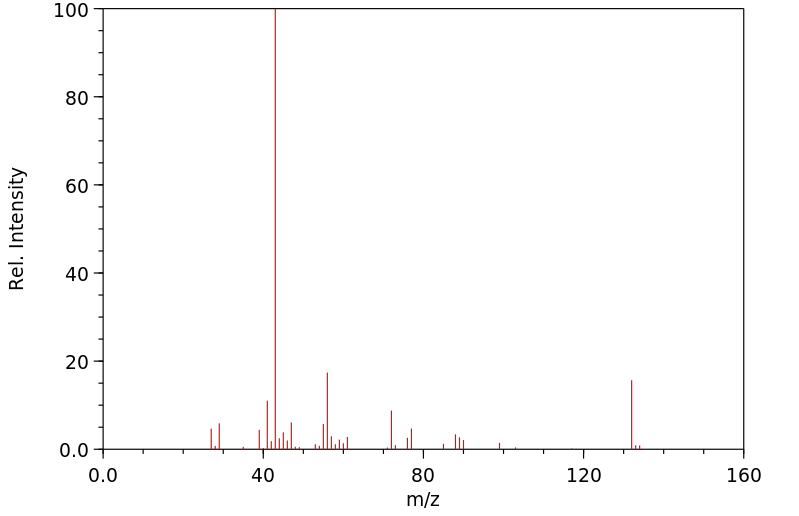硫代乙酸S-正丁酯 | 928-47-2
中文名称
硫代乙酸S-正丁酯
中文别名
S-正丁基硫代乙酸酯ThioaceticacidS-n-butylester
英文名称
S-butyl ethanethioate
英文别名
Thioessigsaeure-S-butylester;S-butyl thioacetate;S-(n-Butyl)-thioacetat;S-n-Butyl-thiolacetat;Essigsaeure-n-butyl-thioester;Thioessigsaeure-butylester
CAS
928-47-2
化学式
C6H12OS
mdl
——
分子量
132.227
InChiKey
XBHDWERUSGIZNS-UHFFFAOYSA-N
BEILSTEIN
——
EINECS
——
-
物化性质
-
计算性质
-
ADMET
-
安全信息
-
SDS
-
制备方法与用途
-
上下游信息
-
文献信息
-
表征谱图
-
同类化合物
-
相关功能分类
-
相关结构分类
物化性质
-
沸点:162-163°C
-
密度:0,947 g/cm3
-
闪点:162-163°C
-
LogP:2.388 (est)
-
保留指数:951
-
稳定性/保质期:
在常温常压下保持稳定,应避免与强氧化剂接触。
计算性质
-
辛醇/水分配系数(LogP):1.9
-
重原子数:8
-
可旋转键数:4
-
环数:0.0
-
sp3杂化的碳原子比例:0.83
-
拓扑面积:42.4
-
氢给体数:0
-
氢受体数:2
安全信息
-
危险等级:3
-
安全说明:S23,S24/25
-
危险类别码:R10
-
海关编码:2930909090
-
包装等级:III
-
危险品运输编号:UN 1993
-
危险类别:3
-
危险性防范说明:P210,P240,P241,P242,P243,P261,P264,P271,P280,P302+P352,P303+P361+P353,P304+P340,P305+P351+P338,P312,P332+P313,P337+P313,P362,P370+P378,P403+P233,P403+P235,P405,P501
-
危险性描述:H225,H315,H319,H335
-
储存条件:请将容器密封保存,并储存在阴凉、干燥的地方。
SDS
上下游信息
-
上游原料
中文名称 英文名称 CAS号 化学式 分子量 二丁基硫醚 Dibutyl sulfide 544-40-1 C8H18S 146.297
反应信息
-
作为反应物:参考文献:名称:磺酰氯和环亚胺的多种反应摘要:摘要 虽然烷烃磺酰氯与线性亚胺反应生成 β-磺胺衍生物,但在本研究中,它们与各种环状亚胺反应,包括 1-吡咯啉、恶唑啉、5,6-二氢-4H-恶嗪和噻嗪,4, 5-二氢-3H-苯并[c]氮杂和3,4-二氢异喹啉,用于生产多种产品,而不是β-舒坦衍生物。结果表明,烷烃磺酰氯与环状亚胺反应生成N-烷烃磺酰基环状亚胺离子,在反应体系中受到水和氯阴离子等亲核试剂的攻击,生成加成产物。亚胺中间体不能通过闭环形成β-舒坦衍生物。芳烃磺酰氯与环状亚胺反应时表现出类似的行为。研究了磺酰氯与亚胺反应的范围和局限性。图形概要DOI:10.1080/10426507.2011.608097
-
作为产物:描述:参考文献:名称:在水中高效合成有机硫代乙酸酯摘要:硫代乙酸盐作为硫醇的前体是合成其他有机硫化合物的有趣起点。本文中,我们提出一种简单,有效和快速的方法,以水为溶剂获得有机硫代乙酸盐。考虑到过去几十年来对环境友好的合成方法的高度重视,我们证明了硫代乙酸根阴离子作为亲核试剂在水性介质中进行亲核取代反应的作用和强度。使用碳酸钾作为安全和温和的碱,在pH控制下进行反应以防止甲磺酸酯原料分解。简单的后处理即可获得具有优异收率和可接受纯度的产品。DOI:10.1039/c8ob01896k
文献信息
-
Ruthenium(III) chloride catalyzed acylation of alcohols, phenols, thiols, and amines作者:Surya Kanta DeDOI:10.1016/j.tetlet.2004.02.071日期:2004.3Ruthenium(III) chloride catalyzes the acylation of a variety of phenols, alcohols, thiols, and amines under mild conditions. Some of the major advantages of this method are high yields, short reaction times, ease of operation, and compatibility with other protecting groups.
-
[EN] 6-MEMBERED URACIL ISOSTERES<br/>[FR] ISOSTÈRES D'URACILE À 6 CHAÎNONS申请人:CV6 THERAPEUTICS NI LTD公开号:WO2018098204A1公开(公告)日:2018-05-31Provided herein are dUTPase inhibitors, compositions comprising such compounds and methods of using such compounds and compositions.本文件提供了dUTPase抑制剂,包含此类化合物的组合物以及使用此类化合物和组合物的方法。
-
Ruthenium(III) Chloride Catalyzed Acylation of Alcohols, Phenols, and Thiols in Room Temperature Ionic Liquids作者:Zhiwen Xi、Wenyan Hao、Pingping Wang、Mingzhong CaiDOI:10.3390/molecules14093528日期:——Ruthenium(III) chloride-catalyzed acylation of a variety of alcohols, phenols, and thiols was achieved in high yields under mild conditions (room temperature) in the ionic liquid 1-butyl-3-methylimidazolium hexafluorophosphate ([bmim][PF6]). The ionic liquid and ruthenium catalyst can be recycled at least 10 times. Our system not only solves the basic problem of ruthenium catalyst reuse, but also avoids
-
Practical Preparation of Esters and Thioacetates from Alkyl Halides and Carboxylates or Thioacetate Catalyzed by PEG400 without Solvent作者:Yu‐Qing Cao、Guo‐Qiang Wu、Ya‐Bin Li、Zhi Dai、Bao‐Hua ChenDOI:10.1080/00397910600941380日期:2006.11.1Abstract Carboxylic esters and thioacetates were conveniently prepared in good to excellent yields under mild conditions by the reaction of alkyl halides with sodium carboxylates or sodium thioacetate catalyzed by PEG400 in the absence of solvents.
-
CONTROLLED RELEASE PREPARATION申请人:TAKEDA PHARMACEUTICAL COMPANY LIMITED公开号:US20160128945A1公开(公告)日:2016-05-12A controlled release preparation wherein the release of active ingredient is controlled, which releases an active ingredient for an extended period of time by staying or slowly migrating in the gastrointestinal tract, is provided by means such as capsulating a tablet, granule or fine granule wherein the release of active ingredient is controlled and a gel-forming polymer. Said tablet, granule or fine granule has a release-controlled coating-layer formed on a core particle containing an active ingredient.提供了一种受控释放制剂,其中活性成分的释放受到控制,通过在胃肠道内停留或缓慢迁移来延长时间释放活性成分,采用胶囊化片剂、颗粒或细颗粒的方式,其中活性成分的释放受到控制,并且使用了一种凝胶形成聚合物。所述的片剂、颗粒或细颗粒在含有活性成分的核心颗粒上形成了一个受控释放的涂层。
表征谱图
-
氢谱1HNMR
-
质谱MS
-
碳谱13CNMR
-
红外IR
-
拉曼Raman
-
峰位数据
-
峰位匹配
-
表征信息
同类化合物
羧酸-三聚乙二醇-硫代乙酸酯
磷酸)二氢8-羰基腺苷5'-(
硫代甲酰胺
硫代二乙醇酸二异丙酯
硫代乙酸甲酯
硫代乙酸烯丙酯
硫代乙酸氯代丙酯
硫代乙酸丙酯
硫代乙酸S-正丁酯
硫代乙酸S-乙酯
硫代乙酸S-(2-氨基-乙基)酯盐酸盐
硫代乙酸S-(2,3-二氯丙酯)
硫代乙酸(Z)-S-(3-甲基戊-2-烯-4-炔基)酯
硫代乙酸 S-异丙基酯
硫代乙酸 S-(2-氧代丙基)酯
硫代乙酸 S-(2-氟乙基)酯
硫代丙酸甲酯
硫代丙酸S-乙酯
硫代丙酸S-(2-二甲氨基乙酯)
甲硫代酰胺,N,N-二乙基-
甲基-三聚乙二醇-硫代乙酸酯
环戊硫醇乙酸
环己烷羰基硫代羧酸s-叔丁酯
环己基甲硫醇乙酸
氰甲基硫代乙酸
孟鲁司特钠杂质
叔-丁基-3,6,9,12,15,18,21-七氧杂-34-氧代-33-硫杂三十五烷酸酯
卡托普利杂质6
乙酸3-(乙酰巯基)己酯
乙酰硫酯-六聚乙二醇-炔
乙酰硫酯-八聚乙二醇-炔
乙酰硫酯-三聚乙二醇-炔
乙酰基硫醚
乙酰基硫基-PEG4-炔
乙硫酸,S-环丙基酯
乙硫酸,S-1-环己烯-1-基酯
乙硫酸,S-(3-碘丙基)酯
乙硫酸,S-(1,1-二乙基丙基)酯
乙硫基甲醛
乙基三氟巯基乙酯
丙酸烯丙巯酯
丙酸,3-丙氧基-3-硫代-,乙基酯
s-(2-氨乙基)硫代乙酸
S-(4-氰基丁基)硫代乙酸酯
S-癸基2,2-二甲基硫代丙酸酯
S-甲基环戊烯-1-硫代甲酸酯
S-甲基环己烯-1-硫代甲酸酯
S-甲基氰基硫代乙酸酯
S-甲基2-甲基硫代丙酸酯
S-甲基2-丙氧基硫代丙酸酯







